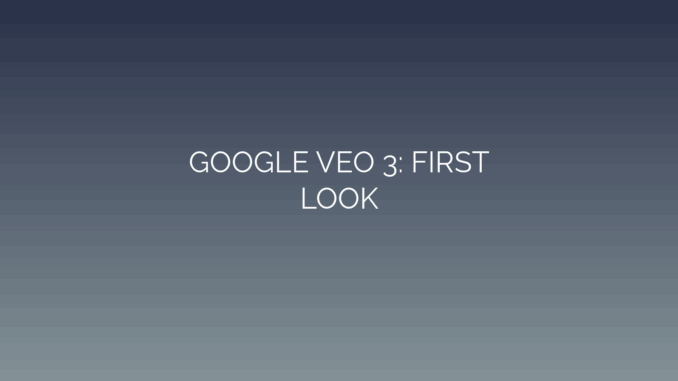
Google Veo 3: First Look
The rapid evolution of AI video generation has reached a pivotal moment with the arrival of Google Veo 3, the latest iteration in Google’s generative video model series. Positioned as a major leap beyond its predecessors, Veo 3 promises unprecedented realism, control, and creative flexibility. This firstlook analysis explores its capabilities, technological foundations, and potential impact on industries ranging from entertainment to education.
The Evolution of Veo: From Concept to Cutting Edge
Google’s journey in AI video began with experimental prototypes, culminating in Veo 1 and its refined successor, Veo 2. While Veo 1 demonstrated basic texttovideo synthesis and Veo 2 improved temporal coherence, both faced challenges in resolution consistency and nuanced motion fidelity.
Veo 3 addresses these limitations headon through architectural innovations:
- Enhanced Temporal Modeling: A redesigned frame-prediction system ensures smoother transitions and lifelike object movements.
- Higher Resolution Output: Native 1080p video generation at 30 FPS, with experimental support for 4K upscaling.
- Reduced Artifacts: Advanced noise-reduction algorithms minimize visual glitches common in AI-generated footage.
Industry analysts note this progression reflects Google’s commitment to closing the gap between synthetic and recorded video.
Core Innovations Driving Veo 3
1. Scalable Diffusion Architecture Veo 3 leverages a hybrid diffusiontransformer model capable of parsing complex prompts into multisecond scene dynamics. Unlike conventional diffusion models, it employs a hierarchical compression strategy, decomposing videos into spatialtemporal “token” sequences. This enables:
- Fine-grained motion control via prompt modifiers (e.g., “slow-motion waterfall at dawn”).
- Consistent object permanence across 60+ second generations.
2. Intuitive Prompt Fidelity Veo 3 interprets contextually rich prompts with remarkable precision. Inputs like “a cyberpunk cityscape with flying cars under neon rain” yield detailed outputs where lighting, weather, and perspective correlate seamlessly. Key enhancements include:
- Cross-attention mechanisms aligning text semantics with visual elements.
- Dynamic style transfer (e.g., “in the style of 1980s anime”).
3. Multimodal Input Support Beyond text, Veo 3 accepts image and audio inputs to guide video synthesis:
- Image-to-video conversion with motion path specification (“rotate around this object”).
- Audio-synced lip movements for dialogue-driven scenes.
Performance Benchmarks and Usability
Google’s internal tests highlight significant gains:
| Metric | Veo 2 | Veo 3 | |||| | Avg. Output Length | ~15 seconds | 45–90 seconds | | Coherence Score | 74% | 92% | | Render Speed | 90 sec/frame | 40 sec/frame |
_ On TPU v5 clusters_
Users interact via a revamped Cinema Editor interface featuring:
- Drag-and-drop timeline editing.
- Real-time preview rendering.
- Color grading and depth-of-field adjustments.
Early creators praise its streamlined workflow, which reduces postproduction time by an estimated 70%.
Real-World Applications
Veo 3 transcends novelty status with tangible use cases:
Film and Advertising
- Rapid storyboarding and pre-visualization.
- Customizable ad variants (e.g., swapping backgrounds per demographic).
Education and Training
- Generating historical reenactments or scientific simulations.
- Interactive VR scenarios for safety drills.
Gaming and Virtual Worlds
- Dynamic NPC animation generation.
- Player-driven narrative expansion.
Competitive Landscape Analysis
Veo 3 enters a market dominated by OpenAI’s Sora and Runway ML. Key comparisons:
- Sora (OpenAI): Excels in imaginative worldbuilding but lacks Veo 3’s granular editing suite.
- Runway Gen-3: Prioritizes accessibility yet trails in resolution and prompt adherence.
Veo 3’s differentiation lies in its enterprisetier scalability and DeepMind integration, enabling physicsbased simulations for engineering and R&D.
Ethical and Practical Considerations
While pushing technical boundaries, Veo 3 intensifies critical debates:
- Misinformation Risks: Hyper-realistic deepfakes could exacerbate fraud and disinformation. Google counters with SynthID watermarking and provenance tracking.
- Creative Labor Impact: Filmmakers voice concerns over job displacement despite Veo 3’s positioning as a collaborative tool.
- Resource Demands: High compute requirements may limit access for independents, raising equity concerns.
Google emphasizes partnershipdriven deployment, including ethical use case audits and education initiatives in media literacy.
The Road Ahead
Veo 3 remains in private alpha, with a public release slated for late 2024. Key anticipated upgrades include:
- Real-time collaboration features.
- Extended coherence for hour-long narratives.
- Integration with Google’s Gemini ecosystem for multimodal reasoning.
Competitive pressure ensures rapid iteration, positioning Veo 3 as a benchmark for the industry.
Final Thoughts
Google Veo 3 represents a quantum leap in generative video technology, blending cinematic quality with usercentric controls. It empowers creators to visualize ideas once confined to imagination—yet demands mindful stewardship to navigate ethical complexities. As barriers between synthetic and organic media dissolve, Veo 3 invites us to redefine the art of storytelling. With cautious optimism, the creative world watches as this formidable tool approaches its public debut.
Related Topics:
- “AI Video Models: Shifting Landscape in 2024”
- “Ethics in Generative Media: A Policy Framework”
- “Cinema Editor: Behind Google’s Creative Suite Revolution”

Leave a Reply